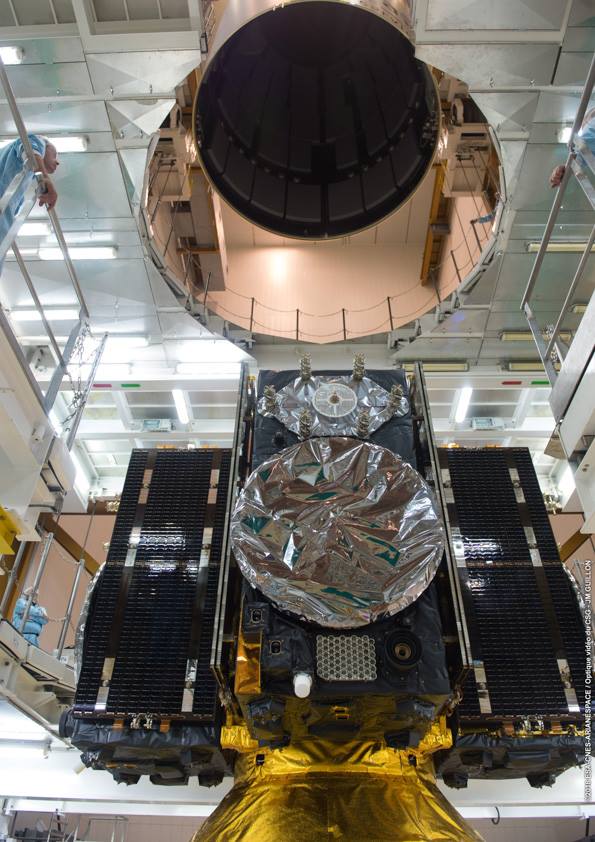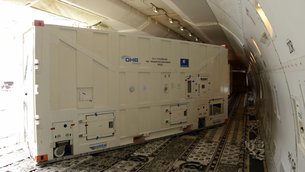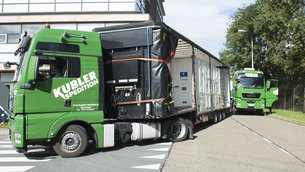Ariane 5 ready for first payload of Galileo satellites
The first Ariane 5 launcher to orbit Galileo navigation satellites has completed its initial build-up in French Guiana, continuing preparations for Arianespace’s Nov. 17 mission from the spaceport to deploy four more Galileo satellites, according to launch contractor.

The Ariane 5 vehicle equipment bay is shown being lowered into position on the main cryogenic stage in preparation for Flight VA233, the launch of four Galileo satellites. (Photo: Arianespace)
During activity in the Spaceport’s Launcher Integration Building, the heavy-lift vehicle for Arianespace Flight VA233 underwent the assembly process that began by mating Ariane 5’s two solid propellant strap-on boosters with the main cryogenic stage.
The next step was integration of the launcher’s vehicle equipment bay as well as the installation of Ariane 5’s EPS storable propellant stage.
From launcher integration to final assembly
After completion of verifications and systems checkout by production prime contractor Airbus Safran Launchers, the Ariane 5 will be moved to the Spaceport’s Final Assembly Building — where Arianespace takes authority for payload integration and launch.

Ariane 5’s vehicle equipment bay is hoisted for integration in the Spaceport’s Launcher Integration Building, in preparation for Flight VA233, the launch of four Galileo satellites. (Photo: Arianespace)
The EPS storable propellant upper stage is powered by a re-ignitable engine that operates with MMH and N2O4 propellants. It differentiates Flight VA233’s launcher from the Ariane 5 ECA versions, which have a cryogenic upper stage and are typically used on Arianespace missions to geostationary transfer orbits with telecommunications satellites.
For Flight VA233, the Ariane 5 ES will carry the quartet of Galileo satellites (weighing 738 kg. each) and their 447-kg. dispenser system to medium-Earth orbit, for deployment at an altitude of approximately 23,222 km.
The upcoming Ariane 5 launch will mark the initial utilization of Ariane 5 in deploying Galileo constellation satellites. Flight VA233 will continue Arianespace’s support of the global positioning satellite system, following seven missions performed with the company’s medium-lift Soyuz that carries a pair of Galileo spacecraft on each flight. Seven Soyuz missions have delivered a total of 14 navigation satellites into orbit since 2011.
Galileo is a key effort for Europe, offering highly accurate positioning with great precision and reliability via a civil global satellite navigation system. The program is funded and owned by the European Union, with overall responsibility for management and implementation held by the European Commission. Design and development of the new generation of systems and infrastructure has been assigned to the European Space Agency.
The spacecraft to be launched on Flight VA233 were built by OHB System in Bremen, Germany, with their navigation payloads provided by Surrey Satellite Technology in the United Kingdom. Airbus Defence and Space developed the dispenser system that will carry and deploy the satellites from Ariane 5.
Quelle: GPS WORLD
-
Update: 22.10.2016
.
Four Galileo satellites are “topped off” for Arianespace’s milestone Ariane 5 launch from the Spaceport

The fueling of Europe’s four Galileo satellites to be orbited on Arianespace Flight VA233 is being performed in the Spaceport’s S3B payload preparation facility.
Fueling operations have begun with the four Galileo spacecraft to be orbited next month from French Guiana on Arianespace’s first launch that uses its Ariane 5 in deploying Europe’s constellation of navigation satellites.
The fueling activity is now underway in the Spaceport’s S3B payload preparation facility. One of the first to be processed is named “Antonianna,” after an Italian child who won a European Commission Galileo drawing competition – with one winner selected from each member state of the European Union.
Weighing between 715 kg. and 717 kg. each, the quartet of Galileo satellites will have a combined liftoff mass of 2,865 kg., and they will be deployed by Ariane 5 into circular orbit during a mission lasting just under four hours.
A morning Ariane 5 launch from the Spaceport
The Ariane 5 launch, designated Flight VA233 in Arianespace’s numbering system, is set for a morning departure from the Spaceport on November 17 at an exact liftoff time of 10:06:48 a.m. in French Guiana (13:06:48 Universal Time – UTC).

The Galileo satellite named after “Antonianna,” an Italian child who won a European Commission Galileo drawing competition, is prepared for fueling in the Spaceport’s S3B payload processing facility.
Flight VA233 will mark Arianespace’s first use of its heavy-lift Ariane 5 to loft Galileo satellites, following seven previous missions with the company’s medium-lift Soyuz. The Soyuz vehicles carried a pair of Galileo spacecraft on each flight, delivering a total of 14 navigation satellites into orbit since 2011.
Galileo is an important infrastructure program for Europe, creating a civil global satellite navigation system that provides highly accurate positioning with great precision and reliability.
This program is funded and owned by the European Union, with overall responsibility for management and implementation held by the European Commission. The European Space Agency has been assigned design and development of the new generation of systems and infrastructure for Galileo.
OHB System in Bremen, Germany built the rectangular-shaped satellites, which are sized at 2.7 x 1.2 x 1.1 meters, with their navigation payloads provided by Surrey Satellite Technology in the United Kingdom.
Quelle: arianespace
-
Update: 27.10.2016
.

Four Galileo ‘topped off’ for November launch
Fueling operations have begun with the four Galileo spacecraft to be launched Nov. 17 from French Guiana. This will be launch contractor Arianespace’s first launch using its Ariane 5 rocket to deploy Europe’s constellation of navigation satellites.
The fueling activity is now underway in the Spaceport’s S3B payload preparation facility. One of the first to be processed is named “Antonianna,” after an Italian child who won a European Commission Galileo drawing competition — with one winner selected from each member state of the European Union.
Weighing between 715 kg. and 717 kg. each, the quartet of Galileo satellites will have a combined liftoff mass of 2,865 kg., and they will be deployed by Ariane 5 into circular orbit during a mission lasting just under four hours.
The Ariane 5 launch, designated Flight VA233 in Arianespace’s numbering system, is set for a morning departure from the Spaceport on Nov. 17 at an exact liftoff time of 10:06:48 a.m. in French Guiana (13:06:48 p.m. Universal Time — UTC).
Flight VA233 will mark Arianespace’s first use of its heavy-lift Ariane 5 to loft Galileo satellites, following seven previous missions with the company’s medium-lift Soyuz. The Soyuz vehicles carried a pair of Galileo spacecraft on each flight, delivering a total of 14 navigation satellites into orbit since 2011.
Galileo is an important infrastructure program for Europe, creating a civil global satellite navigation system that provides highly accurate positioning with great precision and reliability.
This program is funded and owned by the European Union, with overall responsibility for management and implementation held by the European Commission. The European Space Agency has been assigned design and development of the new generation of systems and infrastructure for Galileo.
OHB System in Bremen, Germany built the rectangular-shaped satellites, which are sized at 2.7 x 1.2 x 1.1 meters, with their navigation payloads provided by Surrey Satellite Technology in the United Kingdom.
Quelle: GPSWorld
-
Update: 28.10.2016
.
Ariane 5 rolls out to the Spaceport’s Final Assembly Building in preparation for its November 17 liftoff

The Ariane 5 for Arianespace’s Flight VA233 approaches the Final Assembly Building during its transfer from the Spaceport’s Launcher Assembly Building.
Arianespace’s sixth Ariane 5 for launch this year is ready to receive its multi-satellite payload after being transferred to the Spaceport’s Final Assembly Building in French Guiana.
The heavy-lift workhorse rolled out yesterday from the Launcher Integration Building – where its core cryogenic stage, two solid boosters and cryogenic upper stage were mated by production prime contractor Airbus Safran Launchers – to the Final Assembly Building, marking the formal handover to Arianespace.
Now under Arianespace’s responsibility, the launcher – an Ariane 5 ES version – is set for integration of its payload: four global positioning satellites for Europe’s Galileo navigation system.
An Ariane 5 launch for Europe
The upcoming Ariane 5 launch, designated Flight VA233 in Arianespace’s numbering system, is set for a morning departure from the Spaceport on November 17 at an exact liftoff time of 10:06:48 a.m. in French Guiana.
Weighing between 715 kg. and 717 kg. each, the quartet of European Galileo satellites will have a combined liftoff mass of 2,865 kg., and they will be deployed by Ariane 5 into circular orbit during a mission lasting just under four hours.
The Galileo satellites were built by OHB System in Bremen, Germany, with their navigation payloads provided by Surrey Satellite Technology in the United Kingdom.
---
Galileo satellites begin their launcher hardware integration for Arianespace’s November 17 mission with Ariane 5
The launch campaign for Arianespace’s upcoming Ariane 5 flight from French Guiana has entered its latest phase of preparations, with the mission’s four Galileo satellite passengers being installed on their multi-payload dispenser system.

Two of the four Galileo satellites are shown after their installation on the multi-passenger dispenser system, with a third being positioned for its integration.
This activity – performed in the Spaceport’s S3B clean room – clears the way for the satellites’ integration as a single unit atop the heavy-lift Ariane 5, which was transferred earlier this week from the Launcher Integration Building to the Final Assembly Building, where payload integration is set to occur.
Designated Flight VA233, the upcoming mission will mark Arianespace’s first use of Ariane 5 to loft Galileo satellites, following seven previous missions with its medium-lift Soyuz. It is scheduled as the company’s ninth launch to be performed in 2016, as well as the sixth this year using the heavy-lift workhorse. Arianespace’s full launcher family is rounded out by the light-lift Vega.
Galileo: an important program for Europe
Flight VA233 is scheduled for a November 17 liftoff from the Spaceport in French Guiana at precisely 10:06:48 a.m. local time, with the four Galileo satellites subsequently being deployed into circular orbit during a mission lasting just under four hours.
Galileo is an important infrastructure program for Europe, creating a civil global satellite navigation system that provides highly accurate positioning with great precision and reliability. It is funded and owned by the European Union, with overall responsibility for management and implementation held by the European Commission. Design and development of the new generation of systems and infrastructure has been assigned to the European Space Agency.
OHB System in Bremen, Germany built the Galileo satellites, which are sized at 2.7 x 1.2 x 1.1 meters, while their navigation payloads were supplied by UK-based Surrey Satellite Technology.
Quelle: arianespace
-
Update: 30.10.2016
.

Quelle: ESA
-
Update: 4.11.2016
.
Galileo satellites “meet up” with Arianespace’s Ariane 5 for the first time
Antonianna, Lisa, Kimberley and Tijmen – the latest Galileo spacecraft for Europe’s satellite navigation constellation – have been integrated with their Ariane 5 launcher in French Guiana for a November 17 Arianespace mission.

In preparation for Arianespace’s November 17 Ariane 5 mission, four Galileo satellites are lowered into position for installation atop the heavy-lift vehicle’s central core.
The four satellites – named for winners of a European children’s drawing contest – were installed this week on Ariane 5 in the Spaceport’s Final Assembly Building, in preparation for Arianespace’s 10th mission serving the Galileo program.
Designated Flight VA233 in Arianespace’s numbering system, this is the first of those missions that is using a heavy-lift Ariane 5 ES version, with the four satellites configured on a payload dispenser that will release them in pairs into circular orbit.
Supporting a key European space program
Arianespace previously has lofted 14 Full Operational Capability (FOC) and In-Orbit Validation (IOV) satellites for Galileo from French Guiana with seven missions utilizing its medium-lift Soyuz vehicle, along with two other Soyuz flights from the Baikonur Cosmodrome that deployed the GIOVE-A and GIOVE-B experimental satellites.
Galileo is a European initiative to develop a new global satellite navigation system. Under civilian control, it will offer a guaranteed, high-precision positioning service and will end Europe’s dependence on the American GPS system.
The Galileo constellation will comprise 24 operational satellites, along with spares, with 14 already orbited by Arianespace.
Sixth Ariane 5 mission of 2016
Galileo is funded by the European Union. It features innovative technologies developed in Europe for the benefit of all citizens. The European Commission holds overall responsibility for Galileo’s management and implementation, with the European Space Agency assigned design and development of the new generation of systems and infrastructure.
Each of the spacecraft passengers for Flight VA233 weighs between 715 kg. and 717 kg., and were built by OHB System in Germany with U.K.-based Surrey Satellite Technology supplying the navigation payloads.
The November 17 Ariane 5 mission will be Arianespace’s sixth heavy-lift flight of 2016 and its ninth overall this year with its complete launcher family, which also includes the Soyuz and lightweight Vega vehicles.
Quelle: arianespace
-
Update: 10.11.2016
.
Galileo navigation satellites mounted atop Ariane 5 for launch next week

An Ariane 5 launcher uniquely modified to loft four of Europe’s Galileo navigation satellites on one flight has received its payload for liftoff next week in French Guiana.
The satellite quartet will boost the size of the Galileo fleet to 18 spacecraft. Officials say 24 satellites are needed for the European navigation network to provide global positioning and timing services independent of U.S. or Russian navigation fleets.
Liftoff is set for Nov. 17 at 1306:48 GMT (8:06:48 a.m. EST), or 10:06 a.m. local time at the European-run space base in Kourou, French Guiana.
The launch is a rare morning flight for the Ariane 5, which typically blasts off with large telecommunications satellites with evening launch windows. Next week’s mission is timed for the Ariane 5 to deploy the four new Galileo craft into a specific part of the growing navigation fleet, aiming for one of three orbital planes making up the constellation.
Owned and managed by the European Commission with technical support from the European Space Agency, the Galileo program has launched its 14 existing satellites two at a time aboard Russian-made Soyuz boosters from French Guiana.
The Ariane 5 launch next week is the first of at least three flights by the heavy-duty European-made rocket set to send up four Galileo satellites per mission.
Quelle: SN













